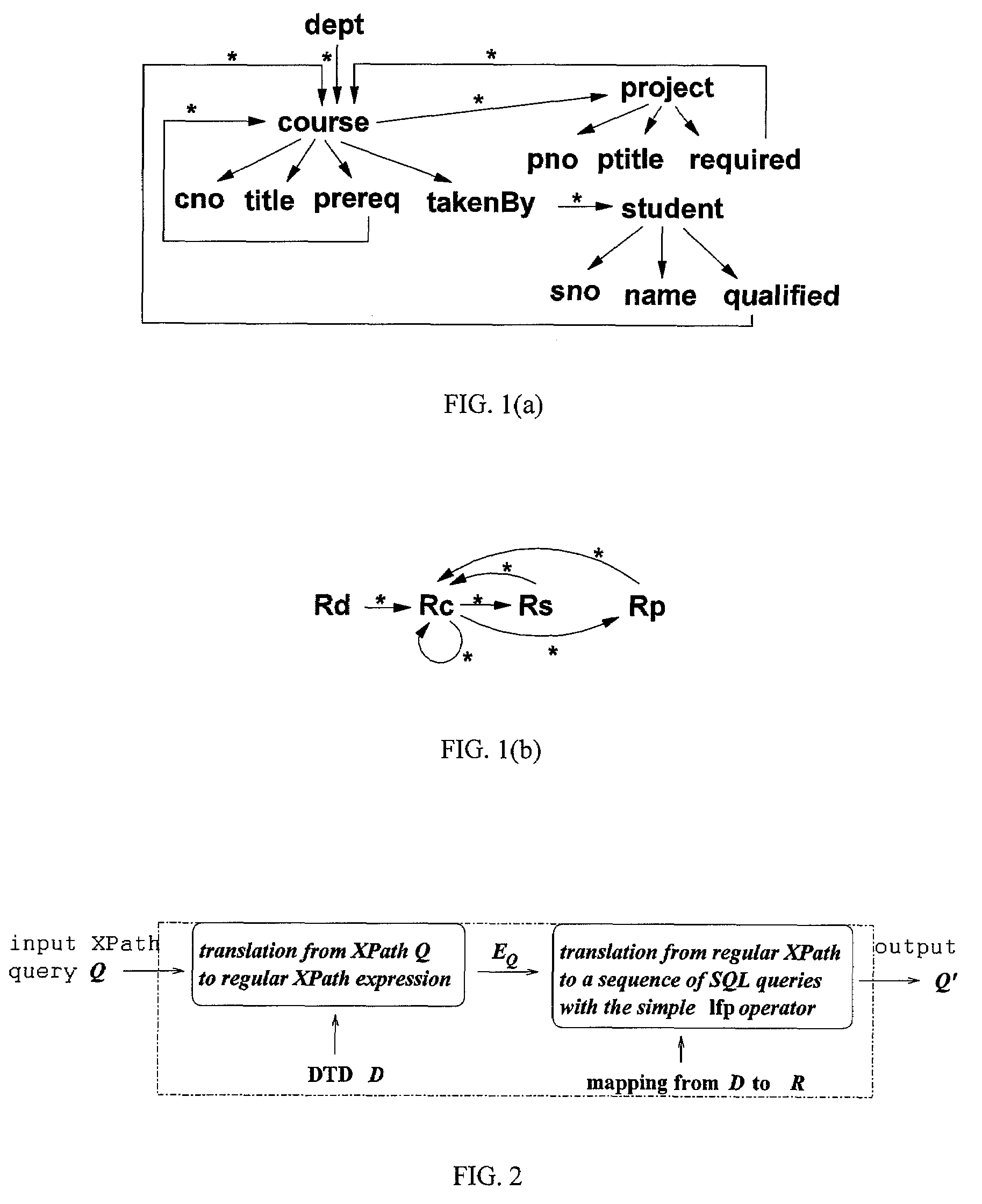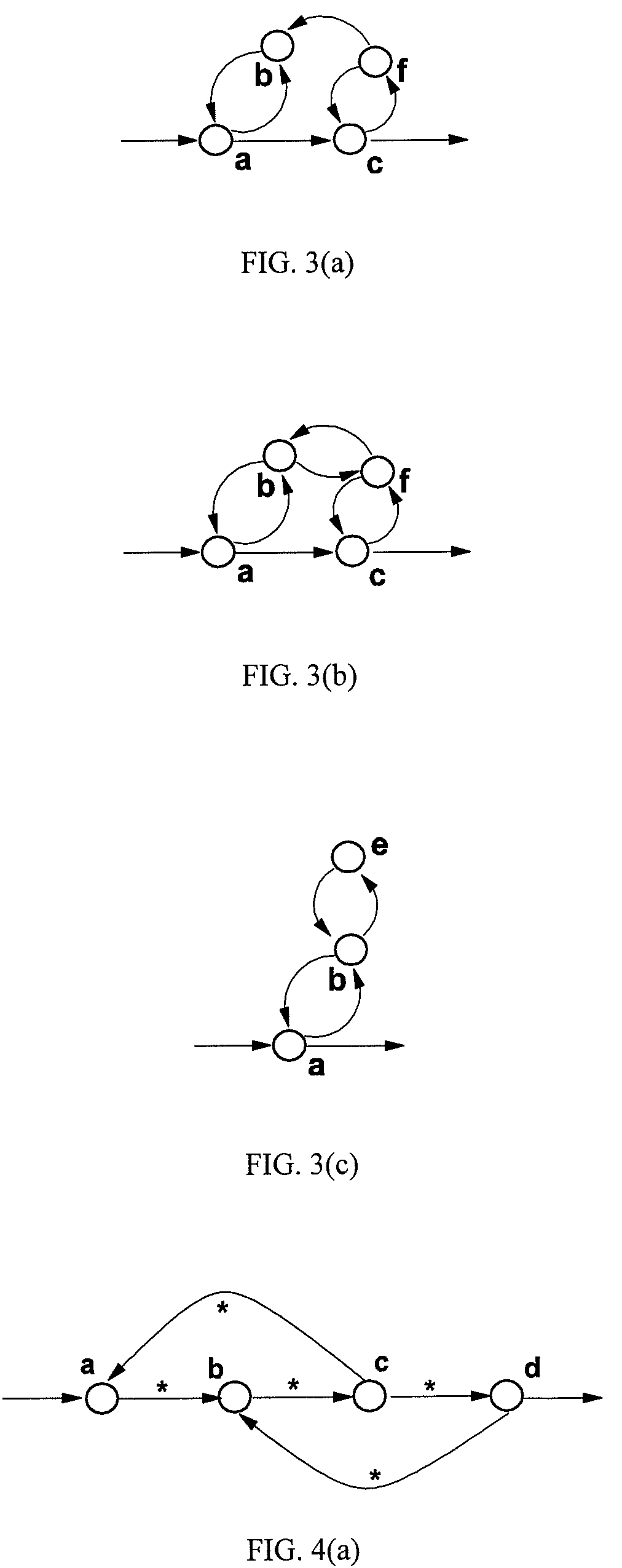Query Translation from XPath to SQL in the Presence of Recursive DTDs
a recursive dtds and query technology, applied in the field of query translation from xpath to sql in the presence of recursive dtds, can solve the problem of only requiring low-end rdbms features, and achieve the effect of less complex
- Summary
- Abstract
- Description
- Claims
- Application Information
AI Technical Summary
Benefits of technology
Problems solved by technology
Method used
Image
Examples
example 6.1
[0029]A dept DTD is depicted in FIG. 1(a), which is a 3-cycle graph. As shown in FIG. 1(a), the dept has a list of course elements. Each course consists of a cno (course code), a title, a prerequisite hierarchy (via prereq), and all the students who have registered for the course (via takenBy). Each student has a sno (student number), a name and a list of qualified courses. A course may have several projects. Each project has a pno (project number), a ptitle (title) and required knowledge of other courses (required). □
6.1.2 XPath Queries
[0030]Consider a fragment of an XPATH query that supports recursion (descendants) and rich qualifiers, given as follows:
p::=ε|A|*|p / p|p / / p|p∪p|p[q]
q::=p|text( )=c|q|qq|qq
where ε, A and * denote the self-axis, a label and a wildcard, respectively; ‘∪’, ‘ / ’ and ‘ / / ’ are union, child-axis and descendants-or-self-axis, respectively; and q is called a qualifier, in which c is a constant, and p is the XPATH sub-query as defined by the above equation.
[0031...
example 6.2
[0033]Consider Two XPATH Queries.[0034]Q1=dept / / project[0035]Q2=dept / course[ε / / prereq / course / cno=“cs66”ε / / project takenBy / student / qualified / / course / cno=“cs66”]
On an XML tree of the dept DTD of FIGS. 1a and 1b, the first query is to find all projects, and the
[0036]
TABLE 1A database encoding an XML tree of the dept DTDFT(a) Rd—d1(b) Rcd1c1c1c2c2c3p1c4s2c5(c) Rsc1s1c1s2(d) Rpc2p1c4p2
second one is to find courses that (1) have a prerequisite cs66, (2) have no project related to them or to their prerequisites, but (3) also have a student who registered for the course but did not take cs66. □
6.1.3 Mapping DTDs into a Database Schema
[0037]The present invention focuses on DTD-based shredding of XML data into relations, e.g., via known shared-inlining techniques as supported by most commercially available RDBMS. A DTD-based shredding is a mapping τd: D→R from XML trees of DTD D to databases of relational schema R.
[0038]To simplify the discussion it may be assumed that τd maps each element of...
example 6.3
[0039]With the shared-inlining technique, the DTD of FIG. 1(a) is mapped to a schema with four relation schemas, Rd, Re, Rp and Rs, representing dept, course, project and student, respectively (see FIG. 1(b) for the simplified representation of FIG. 1(a)). A sample database is given in Table 1, which only shows F and T columns.
6.2 Overview: From XPath to SQL
[0040]The query translation problem from XPATH to SQL may be stated mathematically as follows: For a mapping τd: D→R from XML trees of DTD D to databases of relational schema R, it is to find an algorithm that, given an XPATH query Q, effectively computes an equivalent sequence of relational queries Q′ such that for any XML tree T of the DTD D, Q(T)=Q′(τd(T)).
[0041]This section reviews the approach proposed by Krishnamurthy et al. in a paper entitled “Recursive XML Schemas, Recursive XML Queries, and Relational Storage: XML-to-SQL Query Translation” published in ICDE 2004—the only existing solution for the query translation probl...
PUM
 Login to View More
Login to View More Abstract
Description
Claims
Application Information
 Login to View More
Login to View More - R&D
- Intellectual Property
- Life Sciences
- Materials
- Tech Scout
- Unparalleled Data Quality
- Higher Quality Content
- 60% Fewer Hallucinations
Browse by: Latest US Patents, China's latest patents, Technical Efficacy Thesaurus, Application Domain, Technology Topic, Popular Technical Reports.
© 2025 PatSnap. All rights reserved.Legal|Privacy policy|Modern Slavery Act Transparency Statement|Sitemap|About US| Contact US: help@patsnap.com



